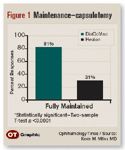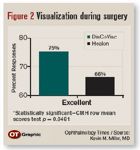Article
OVD protects tissues, maintains space and clarity
Previously, ophthalmic viscosurgical devices (OVDs) could be divided into two camps: dispersive OVDs and cohesive OVDs. Both have pros and cons. Cohesive OVDs create and maintain space, they don't trap air bubbles against the endothelium, and they are easy to remove at the end of the surgery. However, they don't coat tissues well.

In contrast, dispersive OVDs selectively move and isolate tissues, such as exposed vitreous, and they are very protective of the corneal endothelium throughout lens removal. However, they trap air bubbles and are difficult to remove.
An ideal OVD would have the benefits of both dispersive and cohesive agents with none of the disadvantages. In March 2005, DisCoVisc (Alcon Laboratories, Inc., Fort Worth, TX), a new OVD that falls somewhere between purely cohesive and purely dispersive agents, was approved by the FDA. It was designed to protect tissues like a dispersive OVD, while maintaining space and clarity like a cohesive OVD. Additionally, it is easy to remove after surgery.
Clinical trial data
In the FDA clinical trial, DisCoVisc provided the benefits of both cohesive and dispersive OVDs. This masked, randomized trial compared DisCoVisc with Healon (Advanced Medical Optics, Santa Ana, CA) and included 249 patients at nine sites. Patients were not allowed to receive any prophylactic IOP-reducing medications. Postop visits were at 6 hours and at 1, 7, 30, and 90 days.
Primary study parameters were pressure spikes above 30 mm Hg and endothelial cell density changes. Surgeons also reported how each viscoelastic performed at each step of the procedure, using a rating system of excellent, good, adequate, or poor.

As expected, DisCoVisc performed better regarding percentage change in endothelial cell density. With DisCoVisc, the percentage of change was –6.4%, and with Healon, the percentage of change was –8.8%.
DisCoVisc was also much better at maintaining the anterior chamber during capsulotomy (Figure 1). In fact, 81% of DisCoVisc eyes had fully maintained anterior chambers, compared with 31.0% of eyes with Healon. This difference was statistically significant.
Additionally, much more DisCoVisc remained in the eye after phaco compared with Healon. After phaco, 21.7% of DisCoVisc was retained in the eye compared with 6.2% of Healon.
I expected both OVDs to perform similarly in maintaining the anterior chamber during IOL insertion. However, DisCoVisc did a statistically significantly better job at maintaining the anterior chamber. In fact, 87% of DisCoVisc eyes had full anterior chamber maintenance compared with only 48% of Healon eyes.
Newsletter
Don’t miss out—get Ophthalmology Times updates on the latest clinical advancements and expert interviews, straight to your inbox.




